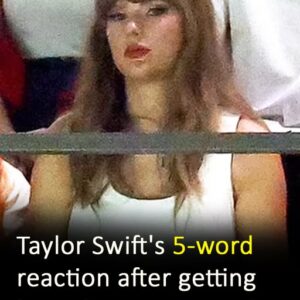Fans Are Left Speechless as Kendrick Lamar Delivers a Surprise Song at the Super Bowl
A Night of Unpredictable Entertainment at Super Bowl LIX
Every Super Bowl is a spectacle, but Super Bowl LIX at Caesars Superdome in New Orleans proved that when it comes to live entertainment, surprises can come both on and off the field. As fans worldwide watched the Kansas City Chiefs and the Philadelphia Eagles face off in a high-stakes gridiron battle, another story was unfolding behind the scenes. Amid the dazzling lights and the raucous cheers of tens of thousands in attendance, renowned rapper Kendrick Lamar took to the halftime stage and delivered a surprise rendition of his diss track “Not Like Us.”
The unexpected performance instantly grabbed headlines and ignited debates not only among die-hard sports fans but also within the music industry and on social media. In a night that was already brimming with excitement and anticipation, Lamar’s daring choice would soon become the talk of the event, revealing that the Super Bowl’s halftime show has become a platform for bold artistic statements—even those that court controversy.
II. A Bold, Unscripted Move in a High-Pressure Environment
For weeks leading up to Super Bowl LIX, rumors swirled about what artists might appear during the much-anticipated halftime show. When Kendrick Lamar stepped onto the stage, many wondered if he would play it safe or push the boundaries with his setlist. Speculation was rife about whether he might perform one of his harder-hitting tracks, and many believed that including “Not Like Us”—a song that had recently found itself at the center of legal and public controversy—was too risky for such a grand stage.
Yet, in an act that can only be described as bold, Lamar did exactly what his critics said he wouldn’t: he launched into a live performance of “Not Like Us,” a diss track now infamous for its scathing lyrics and incendiary references. During his set, Lamar rapped lines that sent shockwaves through the packed stadium. One particularly jaw-dropping verse included, “Say, Drake, I hear you like ’em young / You better not ever go to cell block one,” a lyric that left fans and onlookers in stunned silence.
The performance was electrifying. In a matter of moments, Lamar’s live delivery of the track transformed the halftime show into a live-wire moment of cultural rebellion. The decision to perform “Not Like Us” was not simply an artistic choice—it was a direct challenge to critics who claimed that the controversial subject matter was unsuitable for the family-friendly atmosphere of the Super Bowl. With every bar, Lamar reminded everyone watching that live performance is as much about taking risks as it is about showcasing talent.
III. The Controversial Backdrop: Legal Battles and Lingering Tensions
Lamar’s decision to perform “Not Like Us” did not occur in a vacuum. The track has been mired in controversy for several months, fueling legal battles and public outcry. At the heart of the storm is a high-profile lawsuit involving rival artist Drake. Drake, a 38-year-old superstar known for his own chart-topping hits, has been locked in a public feud with Lamar that has spilled over into the legal arena.
Drake’s legal team has accused Universal Music Group of intentionally pushing controversial material to create viral moments and provoke backlash. The lawsuit alleges defamation and harassment, with Drake’s camp claiming that the release of “Not Like Us” was part of a calculated strategy. One particularly incendiary line in the track—where Lamar controversially refers to Drake as a “certified p**dophile”—has ignited fierce debates. Drake has vehemently denied the claims and labeled the allegations as outrageous, making the situation even more volatile.
Given this tumultuous backdrop, Lamar’s performance was a high-wire act. Some industry insiders feared that performing the track live would open up even more legal vulnerabilities, while others applauded him for taking a stand. In choosing to perform the song, Lamar not only embraced the controversy but also sent a clear message: he was unafraid to use his platform to challenge rivals and stand by his artistic vision, regardless of the legal risks involved.
IV. Social Media Erupts: Reactions That Shaped the Narrative
No major Super Bowl moment today is complete without the instantaneous, global echo provided by social media. As soon as Kendrick Lamar’s controversial performance began, platforms like Twitter, Instagram, and TikTok exploded with activity. Fans, critics, and casual viewers all had their say about the live rendition of “Not Like Us.”
Immediate Shock and Awe
Within seconds, tweets and video clips showcasing Lamar’s razor-sharp delivery and defiant energy started to trend. One widely circulated tweet read, “Kendrick Lamar is cooking Drake live at the Super Bowl—this is pure fire!” Others marveled at the unexpected twist, with comments like, “I can’t believe he just dropped that verse—Drake must be reeling!” The immediate reaction was a mixture of shock, admiration, and even laughter, as fans reveled in the spectacle of it all.
Praise for Fearless Delivery
Many social media users praised Lamar for his boldness. Comments celebrating his stage presence were common: “The way Kendrick looked right before that line was priceless,” and “Lamar just showed us what real artistry looks like—no fear, all passion.” These messages resonated strongly with fans who see the rapper as a champion of artistic freedom, willing to risk backlash to speak his truth.
Divided Opinions and Heated Debates
However, not every reaction was uniformly positive. Some critics argued that the performance was overly provocative for a live event with such a massive, diverse audience. A few tweets expressed concerns that pushing such controversial content might alienate family viewers or damage the Super Bowl’s reputation as a wholesome spectacle. One user commented, “It’s the Super Bowl—shouldn’t the halftime show be about unity, not fueling old beefs?” Such dissenting opinions sparked debates across forums and social media threads, highlighting the deeply polarized nature of public opinion on artistic expression in major events.
In the end, though, the vast majority of reactions celebrated Lamar’s willingness to take risks. The incident quickly became a case study in how live performance can serve as a catalyst for cultural discussion—a moment where art, law, and personal rivalry collided in real time.
V. Behind the Scenes: Halftime Show Protocols and the Art of Live Performance
For any artist stepping onto the Super Bowl halftime stage, the constraints are immense. The halftime show is famous not only for its star power but also for its strict regulations. Every performer must contend with a set list shortened to fit within a tight 13-minute window, ensuring that the show remains a high-energy medley rather than a full-length concert. Additionally, explicit language and certain gestures are heavily censored, given the broad, family-friendly audience that the Super Bowl attracts.
The Clock Is Ticking
Performers must be ready to take the stage within a six-minute window regardless of delays or other unforeseen issues. This means that every second is meticulously planned, rehearsed, and executed. Artists have little room for improvisation—a factor that makes Kendrick Lamar’s performance all the more impressive. Within those few precious minutes, he managed to deliver a performance that was both polished and dangerously daring, demonstrating not only his technical skill but also his ability to command the moment.
Navigating Censorship and Public Expectations
Censorship rules are another major hurdle. The broadcasting authorities enforce strict guidelines to ensure that the content remains appropriate for viewers of all ages. Yet, Lamar’s performance, with its raw energy and edgy lyrics, pushed the envelope. The fact that he chose to perform “Not Like Us”—a song already under legal scrutiny—within these limitations speaks to his commitment to authentic expression. It also raises questions about whether the traditional boundaries of the halftime show can—or should—be stretched in favor of artistic integrity.
Lessons from the Past
The stakes are high; the history of halftime shows is littered with cautionary tales. Remember M.I.A.’s infamous middle-finger display during Madonna’s performance at Super Bowl XLVI, which led to a hefty fine of $16.6 million. Incidents like these underscore the risks artists take when they choose to push boundaries on such a public platform. Kendrick Lamar’s calculated gamble, therefore, is not just a performance—it’s a statement about the evolution of live entertainment and the changing expectations of audiences in a digital age.
VI. The Rivalry: Kendrick Lamar Versus Drake
Central to the drama of the performance is the simmering rivalry between Kendrick Lamar and Drake—a feud that has grown over the years through a series of pointed diss tracks, public jabs, and heated debates among fans. Their ongoing conflict is one of the most talked-about in modern music, and every time one artist references the other in a live setting, the stakes are amplified.
The Historical Feud
Kendrick Lamar and Drake have long been compared as two of the most influential voices in contemporary hip-hop. While both have enjoyed immense success, their artistic approaches and public personas differ markedly. This contrast has fueled a rivalry that is as much about creative expression as it is about personal pride. Over the years, Lamar’s lyrics have occasionally taken aim at Drake, provoking strong reactions from both fan bases.
A High-Wire Act on the Big Stage
By choosing to perform “Not Like Us,” Lamar was not only reiterating his artistic message but also taking another direct shot at Drake. In his live set, the pointed references to Drake were delivered with such force that they resonated immediately with the audience and online commentators alike. The line, “Say, Drake, I hear you like ’em young / You better not ever go to cell block one,” was a moment that left many fans in disbelief, sparking waves of reaction on social media. For supporters of Lamar, it was a moment of vindication—a clear signal that he was unafraid to address the controversy head-on. For Drake’s loyalists, it only deepened the intrigue and tension surrounding the rivalry.
The Legal and Cultural Stakes
Complicating the matter further is the legal fallout surrounding “Not Like Us.” Drake’s lawsuit against Universal Music Group for the release of the track has only added fuel to the fire. This legal battle not only intensifies the personal stakes for both artists but also transforms the performance into a public commentary on the intersection of art, law, and personal vendettas. In performing the track live, Lamar embraced the controversy and positioned himself as a fearless provocateur—one willing to risk legal repercussions and public backlash in the name of artistic expression.
VII. The Social Media Storm: Reactions from Fans and Critics
As with every landmark moment at the Super Bowl, the digital world did not waste a second in amplifying every detail of Kendrick Lamar’s performance. Social media platforms became the battleground for opinions, with fans and critics alike sharing their instantaneous reactions, memes, and video clips.
Celebratory Chants and Viral Memes
In the minutes following Lamar’s daring performance, fans flooded Twitter with messages of excitement and support. One tweet exclaimed, “Kendrick Lamar is serving Drake a piece of his mind LIVE at the Super Bowl—this is history in the making!” Other users posted video loops of Lamar’s delivery, highlighting the intensity and passion with which he performed. The performance soon became the subject of countless memes that both celebrated his audacity and humorously imagined what his next move might be. The digital celebration was a testament to the power of live art to spark collective excitement.
Heated Debates and Divided Opinions
However, not everyone embraced the performance with open arms. A segment of viewers and critics argued that such provocative content was inappropriate for a live event that caters to families and viewers of all ages. Some pointed to the strict guidelines of the halftime show, arguing that Lamar’s choice to include controversial lyrics was a reckless overstep. These voices, while fewer in number, added to the already intense online debates, forcing both sides to confront the question: How far should artists go when performing at such high-profile events?
The Ripple Effect on Music and Pop Culture
The conversation wasn’t limited to whether the performance was appropriate—it also delved into what it meant for the future of live entertainment. Many social media users speculated that Lamar’s bold move might encourage other artists to push the envelope, even in contexts where the stakes are astronomically high. Hashtags like #LamarLive and #NotLikeUsAtTheSB quickly trended, symbolizing not just a reaction to a single performance, but a broader call for artistic freedom in the face of commercial and regulatory pressures.
VIII. Implications for the Future of Live Performances
Kendrick Lamar’s audacious performance at Super Bowl LIX is likely to have lasting repercussions for live music events, especially those held during major sporting spectacles. Here, we explore what this moment might signal for the future.
Redefining the Halftime Show
For decades, the Super Bowl halftime show has evolved from a mere intermission into a showcase for groundbreaking musical performances. Lamar’s choice to perform a track steeped in controversy and legal conflict has pushed the boundaries of what is considered acceptable on this global stage. It challenges event organizers and broadcasters to rethink their guidelines, balancing the need to maintain a family-friendly atmosphere with the desire to allow artists the freedom to express themselves fully.
A Catalyst for Artistic Innovation
In an era when the lines between music, sports, and digital media blur more every day, Lamar’s performance is emblematic of a broader trend: the willingness of artists to take risks and provoke thought. Future live performances may see even more artists daring to challenge conventional norms, knowing that the instantaneous feedback of social media can turn bold moves into cultural milestones. This is not simply about shock value—it’s about creating moments that resonate and spark dialogue, ensuring that live events remain dynamic and unpredictable.
Navigating Legal and Censorship Challenges
At the same time, the performance has highlighted the challenges inherent in navigating the legal and regulatory frameworks that govern live broadcasts. As seen with Lamar’s performance, artists must contend with censorship rules, time constraints, and the risk of legal fallout when they choose to push the envelope. This incident may force broadcasters and event organizers to reexamine how these rules are applied, perhaps paving the way for a more flexible approach that still respects the diverse audience of the Super Bowl.
IX. A Landmark Moment in Super Bowl History
In the end, Kendrick Lamar’s surprise performance of “Not Like Us” stands as one of the most talked-about and controversial moments in recent Super Bowl history. It was a performance that not only captivated fans but also ignited debates across multiple spheres—legal, cultural, and artistic.
An Event to Remember
For those who witnessed the performance live, the memory of Lamar’s defiant delivery and the palpable tension in the Superdome will likely remain etched in their minds for years to come. For others, the digital footprint of that moment—the viral videos, trending hashtags, and passionate online debates—serves as a reminder of the power of live art to challenge, provoke, and inspire. Whether one views the performance as a brilliant act of defiance or a reckless provocation, there is no denying that it has added a new chapter to the legacy of the Super Bowl halftime show.
Shaping the Narrative of Live Entertainment
Beyond the immediate shock and controversy, the performance has broader implications for how live events are perceived. It underscores the idea that major stages like the Super Bowl are not simply about showcasing popular music or sports talent; they are arenas where societal debates are played out in real time. By daring to perform a controversial track with unapologetic intensity, Kendrick Lamar has not only reinforced his reputation as a boundary-pushing artist but has also set a new standard for what it means to engage with an audience on a global scale.
The Power of Provocative Art
At its core, Lamar’s performance is a celebration of provocative art—the kind that forces us to question norms, confront uncomfortable truths, and ultimately, reimagine what is possible. In a world increasingly driven by digital immediacy, moments like this remind us that art can be both a mirror and a catalyst—a reflection of our current cultural climate and a spark for change. As we move forward, the impact of this performance will likely ripple through both the music and sports industries, inspiring future artists to embrace their creative visions without fear of censorship or backlash.
X. Conclusion: The Enduring Legacy of a Bold, Unapologetic Performance
Super Bowl LIX at Caesars Superdome in New Orleans will be remembered for many reasons—the thrilling football, the mesmerizing halftime show, and the myriad moments that captured the collective imagination of millions. Among these, Kendrick Lamar’s surprise rendition of “Not Like Us” will undoubtedly stand out as a landmark moment—a performance that challenged expectations, defied censorship, and ignited a global conversation about the role of art in our most-watched events.
By choosing to perform a track that is at the heart of a heated legal battle and packed with incendiary lyrics, Lamar not only made a statement about his own artistic integrity but also provided a moment of catharsis for fans who crave authenticity in an increasingly regulated media landscape. His performance, with its potent blend of raw emotion and calculated risk, serves as a reminder that the essence of live art lies in its unpredictability and its capacity to capture the zeitgeist.
In the end, whether you are a fan of Kendrick Lamar’s fearless artistry, a supporter of the rigorous yet evolving protocols of the Super Bowl halftime show, or simply an observer of the fascinating interplay between sports and celebrity culture, this performance offers valuable lessons. It reminds us that true creativity often comes at the intersection of risk and passion, that the best art challenges us to think differently, and that even in the most scrutinized moments, there is beauty in being unapologetically bold.
As debates continue on social media, in boardrooms, and in water-cooler conversations around the world, one thing is clear: the legacy of this Super Bowl moment is not measured in minutes or hashtags but in its enduring impact on the culture of live performance. Kendrick Lamar’s decision to perform “Not Like Us” is a call to all artists—an invitation to push boundaries, to take risks, and to let the world see the unfiltered truth of their creative vision.
So as we reflect on this unforgettable night at Caesars Superdome, let us celebrate not only the spectacle of the game but also the power of live music to transcend expectations, spark controversy, and ultimately, unite us in our shared appreciation for art that dares to be different. In a world where every moment is under a microscope, it is the unfiltered, unapologetic moments—like Kendrick Lamar’s bold halftime performance—that remind us why we cherish live events so deeply.
In summary, Super Bowl LIX delivered a night full of surprises and daring moments, and Kendrick Lamar’s unexpected performance of “Not Like Us” became one of its defining highlights. Against a backdrop of fierce legal battles, longstanding rivalries, and strict performance guidelines, Lamar’s decision to take the stage and perform a controversial diss track underscored his fearless commitment to artistic expression. The subsequent explosion of social media reactions—from ecstatic cheers and viral memes to heated debates over appropriateness—illustrated the profound impact that live performance can have in a hyperconnected world. This incident not only intensified the rivalry between Kendrick Lamar and Drake but also set new expectations for what can be achieved on one of the biggest stages in live entertainment.
As we continue to dissect and discuss this landmark moment, it is clear that the legacy of Lamar’s halftime performance will influence future artists and live events alike. By embracing controversy and navigating the constraints of the Super Bowl’s tightly controlled environment, Kendrick Lamar reminded us that true art is not made for comfort—it is forged in the fires of bold, unapologetic creativity. And in doing so, he has etched his name into the annals of Super Bowl history as an artist who dared to challenge the status quo, leaving an indelible mark on both the music industry and the cultural landscape.
Whether you view the performance as a brilliant act of defiance or as a provocative stunt that pushed too far, there is no denying its impact. It is a moment that will be discussed, debated, and remembered for years to come—a testament to the power of live performance to shock, inspire, and ultimately, transform the way we experience art and culture.
So, here’s to a night of unforgettable surprises at Super Bowl LIX—a night when football, music, and controversy converged in a blaze of creative brilliance. As we look back on Kendrick Lamar’s performance, we are reminded that sometimes, the most powerful art is the kind that challenges us to see the world in a new light, even if just for a few electrifying minutes on a stage that belongs to millions.
This article has explored every angle of Kendrick Lamar’s groundbreaking Super Bowl halftime performance—from the audacity of taking on a controversial track amid legal battles to the ripple effects on social media and the broader implications for live entertainment. In doing so, it has painted a vivid picture of a night when art, law, and celebrity clashed in real time, leaving a legacy that will continue to spark debate and inspire future generations of performers.
As discussions rage on and headlines continue to reference that fateful halftime moment, one thing remains clear: the true magic of live performance lies in its ability to capture the unplanned, the provocative, and the transformative—all in a few unforgettable minutes that remind us why we come together to witness the extraordinary.
Whether you are a devoted hip-hop fan, a follower of the latest celebrity rivalries, or simply someone who marvels at the unpredictable nature of live events, Kendrick Lamar’s performance at Super Bowl LIX serves as a powerful reminder that sometimes, it takes bold risk-taking to create art that resonates with the world. And in t






